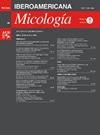氟康唑与天然和药物来源的化合物联合使用对耳念珠菌的抑菌活性研究。
IF 1.6
4区 生物学
Q4 MYCOLOGY
引用次数: 0
摘要
背景:念珠菌病是一种常见且具有临床意义的真菌感染。耳念珠菌因其高传播性、可能引起严重感染以及对多种抗真菌药物具有耐药性而成为一种重要的病原。将氟康唑与其他化合物联合使用以达到加性或协同抗真菌作用已被认为是治疗这些感染的一种有希望的策略。目的:评价氟康唑与7种天然化合物(氯化小檗碱、咖啡酸苯乙酯、一水儿茶素、表没食子儿茶素没食子酸酯、厚朴酚、蛇床子素、水合槲皮素)和7种药物(胺碘酮、氨氯地平、布地奈德、多西环素、布洛芬、米诺环素、替加环素)联用对金耳念珠菌的抑菌作用。方法:对氟康唑单用及与选定化合物和药物联用对21株金黄色葡萄球菌的抑菌活性进行分析,确定其加性或协同作用。测定氟康唑的最低抑菌浓度(mic)并比较不同组合的抑菌浓度。结果:氟康唑与厚朴酚、咖啡酸苯乙酯或水合槲皮素联用分别对38%、9.5%和2%的分离株有加性作用,与水合槲皮素联用对19%的分离株有协同作用。用厚朴酚处理19株氟康唑的mic值降至1 ~ 16μg/mL,用咖啡酸苯乙酯处理17株降至1 ~ 32μg/mL,用水合槲皮素处理8株降至1 ~ 2μg/mL。结论:这些发现突出了氟康唑联合厚朴酚、咖啡酸苯乙酯或槲皮素水合治疗耳球菌感染的潜力。需要进一步的体内研究来评估它们的治疗适用性。本文章由计算机程序翻译,如有差异,请以英文原文为准。
Fluconazole in combination with compounds of natural and pharmaceutical origin: A study on their antimicrobial activity against Candida auris
Background
Candidiasis is a prevalent and clinically significant fungal infection. Candida auris has emerged as an important etiological agent due to its high transmissibility, potential to cause severe infections, and resistance to multiple antifungal drugs. Combining fluconazole with other compounds to achieve additive or synergistic antifungal effects has been proposed as a promising strategy for managing these infections.
Aims
This study aimed to evaluate the antifungal effects of fluconazole in combination with seven natural compounds (berberine chloride, caffeic acid phenethyl ester, catechin monohydrate, epigallocatechin gallate, magnolol, osthole, and quercetin hydrate) and seven drugs (amiodarone, amlodipine, budesonide, doxycycline, ibuprofen, minocycline, and tigecycline) against C. auris.
Methods
The antifungal activity of fluconazole alone and in combination with selected compounds and drugs was analyzed to identify additive or synergistic interactions against 21 isolates of C. auris. Minimum inhibitory concentrations (MICs) of fluconazole were determined and compared across combinations.
Results
Fluconazole combined with magnolol, caffeic acid phenethyl ester, or quercetin hydrate showed additive effects against 38%, 9.5%, and 2% of isolates, respectively, and a synergistic effect with quercetin hydrate in 19% of isolates. Fluconazole MICs were reduced from >64 μg/mL to 1–16 μg/mL with magnolol in 19 isolates, to 1–32 μg/mL with caffeic acid phenethyl ester in 17 isolates, and to 1–2 μg/mL with quercetin hydrate in 8 isolates.
Conclusions
These findings highlight the potential of fluconazole combined with magnolol, caffeic acid phenethyl ester, or quercetin hydrate for managing C. auris infections. Further in vivo studies are warranted to assess their therapeutic applicability.
求助全文
通过发布文献求助,成功后即可免费获取论文全文。
去求助
来源期刊

Revista Iberoamericana De Micologia
MYCOLOGY-
CiteScore
1.90
自引率
0.00%
发文量
17
审稿时长
81 days
期刊介绍:
Revista Iberoamericana de Micología (Ibero-American Journal of Mycology) is the official journal of the Asociación Española de Micología, Asociación Venezolana de Micología and Asociación Argentina de Micología (The Spanish, Venezuelan, and Argentinian Mycology Associations). The Journal gives priority to publishing articles on studies associated with fungi and their pathogenic action on humans and animals, as well as any scientific studies on any aspect of mycology. The Journal also publishes, in Spanish and in English, original articles, reviews, mycology forums, editorials, special articles, notes, and letters to the editor, that have previously gone through a scientific peer review process.
 求助内容:
求助内容: 应助结果提醒方式:
应助结果提醒方式:


